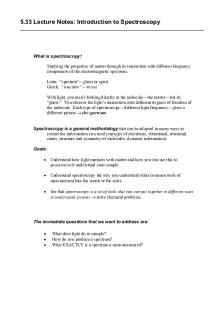Introduction to Spectroscopy 1 PDF

| Title | Introduction to Spectroscopy 1 |
|---|---|
| Author | Anonymous User |
| Course | General Chemistry I |
| Institution | The City College of New York |
| Pages | 3 |
| File Size | 173.5 KB |
| File Type | |
| Total Downloads | 34 |
| Total Views | 154 |
Summary
General Chemistry 1 Lab Report...
Description
1 Introduction to Spectroscopy 1
Introduction to Spectroscopy 1: Question 3: Explain the relationship between A and C, using evidence from the simulation. The relationship between A (absorbance) and C (concentration of solution being measured) is directly proportional. As C increases, so does A at the same proportional rate. As can be seen in the graph for Question 4, each wavelength tested exhibited a proportional absorbance increase as concentration levels increased. For example, when tested at 580 nm wavelength, absorbance increased by approximately 0.01 for every 50 mM increase in solution concentration (see Question 4 for graph).
Question 4: Based on Beer’s Law, would you expect the wavelength used to affect your absorbance versus concentration relationship? What did you observe in the simulation? We would not expect wavelength to affect the relationship in that it would remain proportional (A increasing as C increases), but we would expect wavelength to affect what those proportions are. Because different compounds absorbed light better or worse at different wavelengths, it makes sense that there would be a “sensitive” wavelength which is most absorbed by the compound. So, changing the wavelength will change the rate of absorption, but the A to C will remain linearly proportional. This is observed in the graph below. Changing the wavelength from 580nm to 780nm, the linear proportion between A and C is evident, but the proportion changes from 0.01 absorption increase per 50mM concentration increase to 0.1 absorption increase per 50mM increase in concentration.
2
Nickle(II) Chloride: Concentration (mM)
Absorbance at Preset Wavelength (433 nm)
Absorbance at 580 nm
0.53 0.8 1.06 1.33 1.6
100 150 200 250 300
Absorbance at of 780 nm
0.01 0.02 0.03 0.04 0.04
0.21 0.32 0.42 0.53 0.63
Calibration Curve of NiCl2 l = 1.0 cm 1.8 y = 0.0053x - 0.004 R² = 1
1.6
Absorbance
1.4
Absorbance at Preset Wavelength (433 nm) Absorbance at 580 nm
1.2 1
Absorbance at of 780 nm
0.8
y = 0.0021x + 0.002 R² = 0.9997
0.6
Linear (Absorbance at Preset Wavelength (433 nm) )
0.4
Linear (Absorbance at 580 nm)
y = 0.0002x - 0.004 R² = 0.9412
0.2
0 0
50
100
150
200
250
300
350
Linear (Absorbance at of 780 nm)
Concentration
Question 5a: Choose a solution and keep concentration and path length constant as you graph the absorbance for different wavelengths. Solution chosen: Cobalt(II) Nitrate (Co(NO3)2) Wavelengths measured range from 380-780nm at 20nm increments
3
Absorption Spectrum for Cobalt(II) Nitrate, l = 1 cm, Concentration = 100 mM 0.5 0.45 0.4
Absorbance
0.35 0.3 0.25 0.2 0.15 0.1 0.05 0 350
400
450
500
550
600
650
700
750
800
850
Waveelength (nm)
Question 5b: What is the value for the “preset” wavelength for your solution? Preset = 549nm
Question 5c: Why do you think the “preset” wavelength is the best wavelength to use for this solution? Cobalt(II) Nitrate is most sensitive to this wavelength, and will therefore show the greatest absorbance rate. This is demonstrated on the graph as well....
Similar Free PDFs

Introduction to Spectroscopy 1
- 3 Pages

Spectroscopy
- 5 Pages

1. Introduction to Hematology
- 1 Pages

1. Introduction to Evidence
- 16 Pages

1. Introduction TO Banking LAW
- 9 Pages

Chapter 1 - Introduction to Finance
- 26 Pages

Subject 1-Introduction to Driving
- 16 Pages

1-introduction to public law
- 11 Pages

UNIT 1 Introduction TO ICT
- 7 Pages

Lesson 1 - Introduction to STS
- 4 Pages

Chapter 1 Introduction to Statistics
- 17 Pages
Popular Institutions
- Tinajero National High School - Annex
- Politeknik Caltex Riau
- Yokohama City University
- SGT University
- University of Al-Qadisiyah
- Divine Word College of Vigan
- Techniek College Rotterdam
- Universidade de Santiago
- Universiti Teknologi MARA Cawangan Johor Kampus Pasir Gudang
- Poltekkes Kemenkes Yogyakarta
- Baguio City National High School
- Colegio san marcos
- preparatoria uno
- Centro de Bachillerato Tecnológico Industrial y de Servicios No. 107
- Dalian Maritime University
- Quang Trung Secondary School
- Colegio Tecnológico en Informática
- Corporación Regional de Educación Superior
- Grupo CEDVA
- Dar Al Uloom University
- Centro de Estudios Preuniversitarios de la Universidad Nacional de Ingeniería
- 上智大学
- Aakash International School, Nuna Majara
- San Felipe Neri Catholic School
- Kang Chiao International School - New Taipei City
- Misamis Occidental National High School
- Institución Educativa Escuela Normal Juan Ladrilleros
- Kolehiyo ng Pantukan
- Batanes State College
- Instituto Continental
- Sekolah Menengah Kejuruan Kesehatan Kaltara (Tarakan)
- Colegio de La Inmaculada Concepcion - Cebu




